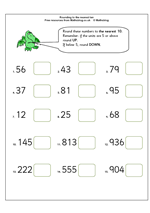 Rounding to the nearest ten is a simple process but can cause confusion. The key digit to look at is the units digit. The rule is:
Rounding to the nearest ten is a simple process but can cause confusion. The key digit to look at is the units digit. The rule is:
If the units are 5 or more, round up to the next whole ten.
If the units are less than 5, round down to the next whole ten below.
Of course, if the units are zero then there is no need to round. (Some children think they have to go down ten more!)
So, 56 to the nearest whole ten is 60
55 to the nearest whole ten is 60
53 to the nearest 10 is 50
If you always round up (or down) when the number ends in 5, you get a bias in a table of values. (So the total is biased high (or low), for example.) Better is to round to the nearest multiple of 20.
You say
“If the units are 5 or more, round up to the next whole ten.”
and
“55 to the nearest whole ten is 50”
But these do not agree.
Hello Keith
Thanks for the email. You spotted the (not quite deliberate) mistake which I have now rectified. I take your point about bias, especially in a long list of values. One of the main aims of rounding at this age is so that children can do quick mental calculations to check that their written answers or use of a calculator are sensible. They will quickly go on to round to the nearest 100 or 1000.
Thanks
Peter